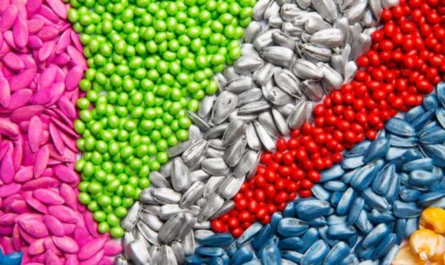Agriculture plays a vital role in feeding the growing global population. To meet the rising food demand, farmers need to maximize crop yields from the available agricultural land. One of the key methods used by farmers to boost crop yields is the application of crop protection chemicals such as pesticides, herbicides, fungicides and other agrochemicals. These chemicals help control weeds, insects, pests and diseases, thereby protecting crops from damage and losses. While crop protection chemicals have contributed significantly to increased food production over the past few decades, their use also raises some environmental and health concerns that need to be addressed sustainably.
Importance of Crop Protection
Without crop protection, uncontrolled weeds, insects and diseases can damage crops, sometimes wiping out entire fields. This leads to substantial losses in crop yields. According to estimates, as much as 40% of global crop production is lost each year due to the attacks of various pests and diseases if no crop protection measures are applied. Losses would be even higher without the use of crop protection chemicals. Higher crop losses mean lower food availability and higher food prices globally. Therefore, protecting crops from such losses through strategic and responsible use of agrochemicals plays a crucial role in ensuring long-term global food security.
Weed Control
Weeds compete with crops for water, nutrients and sunlight, thereby reducing crop yields. Some aggressive weeds can even choke crop plants and take over entire fields if left uncontrolled. Herbicides are widely used by farmers globally for effective weed management in agricultural fields. Pre-emergent herbicides help control weed seeds from germinating while post-emergent herbicides kill existing weeds, allowing crops to grow undisturbed. This reduces crop-weed competition and leads to significant yield gains. For example, herbicide use in soybean cultivation increases yields by 8-15% on average. Proper weed management is thus essential for maximizing crop productivity on existing farmland.
Pest and Disease Management
Pests like insects and diseases pose serious threats to crop health and productivity. A single insect pest like the fall armyworm can devour entire maize fields within days if not controlled in time. Similarly, fungal and bacterial diseases damage multiple crop varieties globally. The timely application of pesticides and fungicides helps protect crops from such losses. For instance, controlling stem rust disease in wheat with fungicides prevents average yield losses of 30%. Like herbicides, these agrochemicals play an indispensable role in integrated pest management programs followed by farmers around the world. They help ensure healthy crops and stability in food production.
Economic Benefits of Crop Protection
Besides safeguarding global food supplies, the crop protection industry also brings significant economic benefits. It generates employment in manufacturing, distribution, marketing and application of different agrochemicals. The crop protection market was estimated at $62 billion in 2019 and is expected to grow at 4-5% annually through 2027. North America, Europe and Asia-Pacific dominate global pesticide sales. Countries like the US, Brazil, India, China, France spend billions of dollars annually on crop protection inputs. This creates a large market that supports thousands of domestic jobs. Farmers realizing higher yields due to effective weed, pest and disease management also earn more incomes. Overall, the economic value of the benefits derived from crop protection is estimated to be 2-4 times the costs involved. This proves the crop protection industry is an essential driver of agricultural economies globally.
Environmental Concerns
While Crop protection chemicals have undoubtedly boosted global food production, their excessive or inappropriate use may also pose risks to the environment and human health. Pesticide runoffs from farmlands can contaminate nearby water bodies and groundwater affecting aquatic life and water quality. Long-term deposition of certain agricultural chemicals in soils may reduce microbial activity and impair soil health. Some pesticides are suspected endocrine disruptors or carcinogens with potential long-term health consequences. There are also concerns about declining biodiversity and killed of non-target insects due to indiscriminate use of broad-spectrum insecticides. Sustainable practices need to be followed to reduce such environmental footprints of intensive agriculture.
Integrated Pest Management
To balance food security needs with environmental protection, experts recommend integrated pest management or IPM approaches. IPM strategies integrate multiple pest control methods – cultural, biological, physical and chemical. The key principles involve promoting healthy soils and crops to boost natural resistance, conserving natural enemies of pests, monitoring pest populations accurately and intervening strategically and judiciously with crop protection chemicals only when economic thresholds are exceeded. Cultural methods involve crop rotation, sanitation practices while biological control uses beneficial insects and microbes as alternatives to synthetic pesticides. Application of agrochemicals as the last resort and following prescribed safety protocols helps prevent overuse and misuse of pest control products. IPM minimizes pesticide usage and associated risks when implemented as a system on farms.
Regulations and Capacity Building
Stringent regulations governing the manufacture, distribution and application of crop protection chemicals also play an important role in their safe use. Major markets apply strict norms for product registrations based on eco-toxicological testing data. The European Union’s REACH regulations are considered rather progressive in this aspect. Recent guidelines by Indian and Chinese governments mandate additional safety precautions. However, implementation remains a concern, especially in developing countries with limited enforcement capacities. Investments in building awareness and training programs for farmers to understand proper agrochemical handling, applications, safety measures and alternative practices can further facilitate sustainable use at the grassroots. Overall stewardship by all players in the agri-input value chain is key to balance food security with environmental protection goals.



